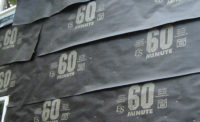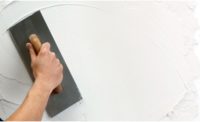The Evolution of Stucco














History
Stucco is one of the oldest building materials available, tracing its roots as far back as 2500 B.C. A mixture of sand, lime and cement that is moist cured for three days to achieve proper strength and reduce cracking, stucco has evolved into a popular cladding choice for renovation and new construction projects. Stucco is an attractive and durable cladding for any type of construction and will last for many years if properly installed and maintained.
Components
A stucco assembly consists of the following components: Weather-resistive barrier, lath, trim accessories, fiber-reinforced stucco, primer and a decorative finish. The weather protection/weather-resistive barrier has two key functions: Provides secondary moisture protection in the event of a crack or breach in the stucco, and prevents the stucco from attaching to the substrate, thus minimizing the risk of cracks in the stucco caused by substrate movement (particularly important for wood-based substrates).
Weather Resistive Barrier
The selection of what type of weather protection/weather-resistive barrier to use is important as it will determine the number of layers needed to meet code requirements as well as influence how vapor permeable the exterior of the wall is.
The first step in the proper stucco installation is the application of the weather resistive barrier over one of the following substrates: Fiber-glass mat exterior sheathing, wood based sheathings, cement board and masonry. The weather resistive barrier can be either a sheet, roll good or fluid applied. In some areas the code may require two layers of a weather resistive barrier which can be any one of the following: Two layers of building paper, a layer of building paper or felt and fluid applied air barrier, or a fluid applied air barrier and paper backed lath. The fluid applied waterproofing/air barrier would be used with conventional sheet goods to provide a two ply weather protection system.
The system would be used where two layers of moisture protection over wood-based sheathing as required by code. The fluid applied waterproofing/air barrier is used as one of the two layers of code prescribed asphalt saturated felt. This system is also used where an air barrier is necessary or required by code (conventional moisture protection—asphalt saturated felt—is not an air barrier.) Accessories are important components that are used at terminations or changes in plane of the stucco assembly. Building codes dictate what type of weather protection is required. For example, the UBC (Uniform Building Code) requires one layer of Type I, Grade D Building paper (barrier paper/water resistant—vapor permeable) beneath stucco. If the sheathing is wood-based two layers of paper are required or one layer of sixty minute paper. The IBC and IRC (International Building Code and International Residential Code) require a minimum 14 LB/100 ft2 (0.683 kg/m2) vapor permeable asphalt saturated felt in compliance with ASTM D 226.
Accessories
Stucco accessories consist of the following components: Weep screed, casing beads, corner beads, expansion and control joints. The weep screed is installed at the base of the wall and sometimes at other horizontal terminations like floor lines. It provides an avenue for incidental moisture to escape in the event of a crack in the stucco and water penetration. At the base of a framed wall it also protects the seam between the framing and the foundation.
Casing beads are installed at stucco terminations such as windows, doors, dissimilar materials, or attachments to the wall assembly. A casing bead with weeps can also be used at the bottom termination of the stucco in place of the weep screed. They provide a straight solid edge for the stucco and a screed by which stucco thickness can be gauged.
Expansion/control joints allow for movement of the stucco as a result of building movement or temperature changes. Stucco requires ¾-inch wide expansion joints at the following locations: Every 144 square-feet, 2.5 width x length, and no more than 18 feet in any direction. Stucco corner beads provide reinforcement at corners, providing a straight and true corner. An expansion joint can be a single v, double v or composed of two casing beads spaced ¾-inch apart in the stucco.
Accessories must meet the requirements of ASTM 1063 and its referenced documents and can be made of PVC plastic, zinc, or galvanized metal with G60 coating. All accessories must have perforated or expanded flanges and selected with grounds for the specified thickness of stucco. Depending on the accessory, it may be placed under or over the weather protection, under or over the lath, nailed into the framing, or wire tied to the lath.
The selection, installation and placement of stucco accessories is mentioned in the manufacturer’s specifications and ASTM 1063: Specification for Installation of Lathing and Furring to Receive Interior and Exterior Portland Cement Based Plaster. The expansion/control joint allows for movement of the stucco in response to building movement or temperature changes.
Lath
Lath is used for reinforcement when stucco is applied to wood framed or steel stud walls, or over a painted substrate. There are many different types of lath acceptable for use in stucco applications. Galvanized steel diamond mesh lath is available in a 2.5-pound and 3.4-pound weight. The decision to use a 2.5 or 3.4-pound weight depends on the overall stucco thickness. Lath should be self-furring and galvanized. Self-furring lath will enable the stucco to key, or bond, to the lath. Lath is available with or without paper backing, in some areas code will recognize the paper back lath as one layer of a weather-resistive barrier. Other options for lath include a 20 gauge 1-inch self-furred galvanized steel woven wire fabric and a plastic lath. Refer to the manufacturer’s specification and code report for the weight and types of lath that are acceptable, fastening methods and test results.
Stucco
Stucco is applied in two applications, a scratch coat that is troweled into the lath and a stucco comb is used to scratch the stucco, next a brown coat is applied over the cured scratch coat. Thickness of the stucco is typically ¾-inch which is achieved by installing a scratch coat of 3/8-inch and a brown coat of 3/8-inch. If a 7/8-inch thick stucco is required, an additional brown coat can be applied to achieve the desired thickness. Fiberglass strands added to the stucco mix increase strength and reduce cracking of the stucco. Fiber reinforced stucco is handled and installed much like conventional stucco. Some of the differences between fiber reinforced stucco and conventional stucco are: Fibers in the mix, mix ratio, thickness of application, and it is generally installed in one or two coats as opposed to three coats. The ingredients are pre-blended except for sand and water, which are added at the jobsite. Fiber reinforcement is an integral part of the stucco, which helps it to resist tensile stress and cracking. Proprietary wall assemblies are listed in manufacturer’s stucco code evaluation reports. It is important that the stucco is allowed to cure properly to limit cracking and achieve proper strength.
Primer
Primer is a white or tinted acrylic water-based material that may contain fine sands. It usually dries in one to two hours under normal weather conditions. Some primers are alkaline resistant that reduce the alkalinity of the stucco surface. A highly alkaline surface condition can affect adhesion and color uniformity of finishes.
The main benefits of priming are to reduce surface alkalinity which prevents problems with adhesion and color uniformity, extend working time of the finish, gives the stucco surface a uniform color, reduces efflorescence, and increases coverage rate of the finish.
Finish Selection
There are four basic texture options for stucco: Fine sand, medium sand, swirl and free form. Finishes can be acrylic, elastomeric or elastomeric siliconized. The elastomeric siliconized may be the best choice since it will bridge any hairline cracks and offer self-cleaning benefits. Specialty finish options that are available for stucco can replicate a brick, limestone, or precast look at a fraction of the cost of the traditional cladding. There is also an option to apply a decorative glaze over the finish to give the stucco a weathered or aged look.
Maintenance
Proper maintenance of any cladding is crucial to the longevity of the structure. There are a few simple steps to maintain a stucco cladding such as cleaning and conducting a site observation. Mildew or stains on the stucco can be removed by applying a solution of 2 cups of tri-sodium phosphate to 1 gallon of water. Apply the solution using a plastic bristle brush and rinsing with water from a garden hose. It is important to perform an observation of the stucco every three to five years to inspect the condition of the expansion/control joints, cornerbeads, trim accessories, sealant joints and parapet coping. If there are any repairs to be completed after a site observation, please refer to the manufacturer’s printed information or industry recommendations for the appropriate repair procedure.
Conclusion
An important factor in the longevity of any cladding is proper application and regularly scheduled maintenance. Stucco is a durable, attractive, affordable and low maintenance cladding choice for commercial and residential structures. Stucco can replicate the look of other claddings such as brick, limestone and precast at a fraction of the cost of the traditional material.
Looking for a reprint of this article?
From high-res PDFs to custom plaques, order your copy today!













